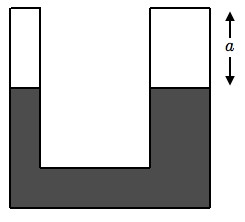U tubes are tricky!
 A U-tube is filled with mercury as shown below, leaving a distance
without filling. The cross section of the right hand of the tube is twice the cross section of the left one. Water is then poured water on the right hand of the tube until the water level reaches the top of the right side. If the level of mercury in the left side of the tube rises a distance
A U-tube is filled with mercury as shown below, leaving a distance
without filling. The cross section of the right hand of the tube is twice the cross section of the left one. Water is then poured water on the right hand of the tube until the water level reaches the top of the right side. If the level of mercury in the left side of the tube rises a distance
where and are positive co-prime integers, find the value of .
Take the density of mercury to be 13.6 times the density of water.
This problem is not original. It is taken from this year's Second Round of the Colombian Physics Olympiad.
The answer is 209.
This section requires Javascript.
You are seeing this because something didn't load right. We suggest you, (a) try
refreshing the page, (b) enabling javascript if it is disabled on your browser and,
finally, (c)
loading the
non-javascript version of this page
. We're sorry about the hassle.
The cross section of left tube is half that of right tube. So, if mercury rises by x on left tube, mercury level falls by 2 x on the other.
So, the total height of water column is a + 2 x
Now, at equilibrium, pressure at point A should be equal to pressure at point B.
P A = P 0 + (a + 2 x ) * 1 * g + (L - 2 x ) * 13.6 * g
P B = P 0 + (x + L) * 13.6 * g
Equating P A and P B and solving,
we get x = ( 1 9 9 1 0 ) a.